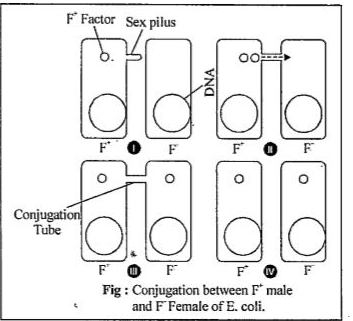Describe the sexual mode of reproduction in bacteria.
Text Solution
Sexual reproduction is actually called "genetic recombination". Sexual reproduction occurs in three ways:
i) Transformation
The transfer of genetic material from one bacterium to another bacterium is called transformation. This process was given by Griffith in 1928. According to him heat killed virulent strain of Diplococcus pneumoniae could transfer their characteristics to non-virulent strain of living bacteria. So the non virulent strain becomes virulent.
ii) Transduction
It is the process of carrying genes from one bacterium to another through the agency of viruses. Transduction was discovered by Zinder and Lederberg in 1952 in Salmonella typhimurium. In this process, a virus picks up one or more bacterial genes instead of its genes. As it attacks to the new bacterial cell, genes are passed into it. The transduction is of two types :
a) Generalised transduction: In this type of transduction, particular genes are not transferred.
b) Restricted transduction : In this type of transduction, particular genes are transferred.
iii) Conjugation
The process of conjugation occurs between two different strains of bacteria (E.coli). One acts as a donor of genes (male) and other as recipient of genes (female). The donor cell possesses sex factor or fertility factor. F-factor is small segment of DNA. It replicates at the time of cell division. The F-factor forms the sex pilli in donor cell. It also forms conjugation bridge between the donor and recipient cells. At the time of conjugation F+ (male) and F− (female), bacterial cells come close to each other. F+ male have 1-4 long pili called sex pili. These pili get attached to the wall of F− cell and for the conjugation bridge. The F+ factor then divides into two parts. One factor remains in donor cell and the ottier migrates into recipient cell through conjugation bridge. The passage of F+ plasmid into the recipient cell changes it into donor cell. It is called sex duction. When F+ plasmid integrates with nucleoid of cell and form episome, it changes the donor cell into HFR (high frequency of recombination).The chromosomes of Hfr become linear. They moves into F− cell through conjugation bridge. Since the complete transfer of DNA occurs, the F− does not enter and resulting zygote is not converted to F+. Thus the newly formed zygote receives only those genes from Hfr which have been transferred during conjugation.

|
Similar Questions
Knowledge Check
The common mode of reproduction in bacteria is
AFissionBBuddingCSexual reproductionDSporulation.
The common mode of reproduction in bacteria is
View SolutionSexual mode of reproduction in protozoa is
View SolutionSexual mode of reproduction in protozoa is
View SolutionSexual mode of reproduction in protozoa is
View SolutionWhy The Sexual Mode Of Reproduction
View SolutionSexual mode of reproduction in protozoa is
View SolutionName modes of asexual reproduction in bacteria
View Solution
